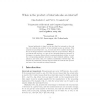Free Online Productivity Tools
i2Speak
i2Symbol
i2OCR
iTex2Img
iWeb2Print
iWeb2Shot
i2Type
iPdf2Split
iPdf2Merge
i2Bopomofo
i2Arabic
i2Style
i2Image
i2PDF
iLatex2Rtf
Sci2ools
RC
1998
1998
When Is the Product of Intervals Also an Interval?
Interval arithmetic is based on the fact that for intervals on the real line, the element-wise product of two intervals is also an interval. This property is not always true: e.g., it is not true if we consider intervals on the set of integers instead of intervals on the set of real numbers. When is an element-wise product or a sum of two intervals always an interval? In this paper, we analyze this problem in a general algebraic setting: we need the corresponding algebraic structures to have (related) addition, multiplication, and order; thus, we consider (consistently) ordered rings. We describe all consistently ordered rings for which the element-wise product and sum of two intervals are always intervals.
| Added | 23 Dec 2010 |
| Updated | 23 Dec 2010 |
| Type | Journal |
| Year | 1998 |
| Where | RC |
| Authors | Olga Kosheleva, Piet G. Vroegindeweij |
Comments (0)

